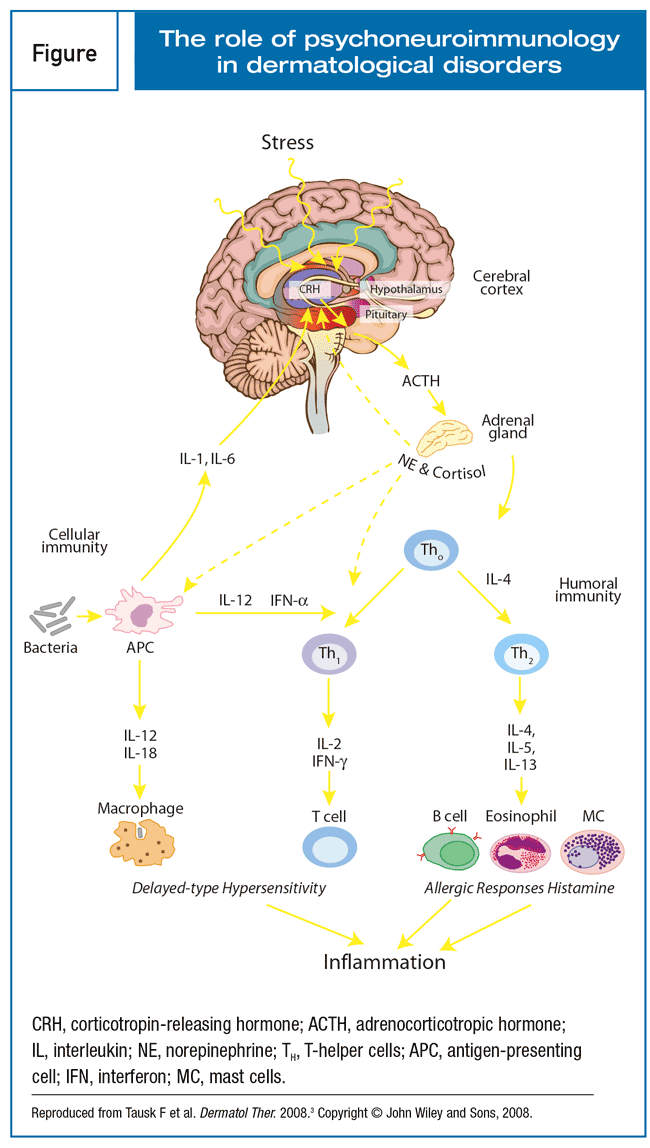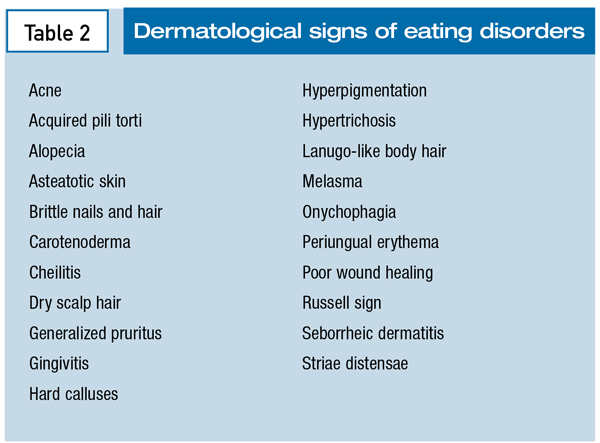Publication
Article
Psychiatric Times
Psychodermatology: When the Mind and Skin Interact
Author(s):
Skin diseases are not just a cosmetic issue; they are associated with a variety of psychological reactions that affect patients’ level of functioning and can produce agony for the family.
Figure

Table 1

Table 2

Table 3


Psychodermatology is a relatively new discipline in psychosomatic medicine. It is the interaction between mind and skin. The two disciplines are interconnected at the embryonal level through ectoderm. There is a complex interplay between skin and the neuroendocrine and immune systems. Skin responds to both endogenous and exogenous stimuli; it senses and integrates environmental cues and transmits intrinsic conditions to the outside world.
The exact prevalence of psychological factors that affect skin disease is not known; however, it has been estimated to be 25% to 33% in various studies.1 Research has shown that stimuli received in the skin can influence the immune, endocrine, and nervous systems at both the local and central levels. In several skin diseases, such as atopic dermatitis, the tissue levels of nerve growth factors and neuropeptides, such as substance P, have been associated with the pathogenesis of disease and markers of disease activity.2
The role of psychoneuroimmunology
As our knowledge in psychoneuroimmunology is expanding, the role of neuropeptides, hormones, and neurotransmitters in psychodermatological disorders is becoming more evident. To better understand the pathogenesis, course, and treatment planning of psychocutaneous disorders, knowledge of psychoneuroimmunology is needed. Stress represents an internal or external force that threatens to disrupt the homeostatic balance of the organism. The organism has the ability to adapt to acute homeostatic challenges; however, chronicity leads to exhaustion, distress, and disease or flare-up of preexisting dermatoses.
Stress activates 2 major neuronal pathways: the hypothalamic-pituitary-adrenal axis and the sympathetic nervous system. The identification of external stress by the brain results in activation of the paraventricular nucleus of the hypothalamus and locus ceruleus. Corticotropin-releasing factor is secreted from the hypothalamus and transported through portal circulation to the pituitary, where it induces the release of adrenocorticotropic hormone from the anterior pituitary to the general circulation. This results in the secretion of glucocorticoids and catecholamines from the adrenal gland.
Cortisol acts as negative feedback on the hypothalamus and inhibits the further release of corticotropin-releasing factor. The cells of the locus ceruleus activate the sympathetic system, which results in the secretion of epinephrine and norepinephrine.
Both catecholamines and cortisol have potent effects on the immune system. They modulate antigen-presenting cells and macrophages and inhibit their activity and the production of interleukin (IL)-12 and IL-18. They also mediate the differentiation of naive T-helper (TH) cells toward TH2, to the detriment of the development of TH1. This tilts the balance toward humoral immunity and activates B cells, mast cells, and eosinophils, with a consequent increase in allergic inflammatory response (Figure). Nerve terminals in cutaneous sensory nerves release neuropeptides, such as calcitonin gene-related peptide and substance P, which have a variety of effects on local inflammatory response; these affect several psychocutaneous disorders.3
Diagnosis
Diagnosing an underlying psychiatric component in a patient who has skin disease involves several dimensions. The evaluation of these dimensions plays a major role in creating an effective treatment plan and includes:
• Establishing a good physician-patient relationship
• Evaluating the patient’s level of functioning as well as different physical and psychosocial stressors that may influence the level of functioning
• Evaluating concurrent affective components that influence the level of functioning
• Weighing the presence of secondary gain
• Considering the real and authentic quality of consultation
Several psychological test instruments have been used to evaluate a patient with psychocutaneous disease: Symptom Checklist-90-Revised, Beck Depression Inventory, Hospital Anxiety and Depression Scale, Dysmorphic Concern Questionnaire, Dermatology Life Quality Index, Skindex Questionnaire, and Marburg Skin Questionnaire.
There is no universally accepted classification of psychodermatological diseases. However, Koo and Lee4 describe the most commonly used classification, which includes the following:
• Psychophysiological disorders: Skin diseases are precipitated or exacerbated by psychological stress. Patients experience a clear and chronological association between stress and exacerbation. Examples in this category include atopic dermatitis, psoriasis, and acne.
• Psychiatric disorders with dermatological symptoms: There is no skin condition and everything seen on the skin is self-inflicted. These disorders are always associated with underlying psychopathology and are known as stereotypes of psychodermatological diseases. Examples include dermatitis artefacta, trichotillomania, body dysmorphic disorder, and neurotic excoriations.
• Dermatological disorders with psychiatric symptoms: Emotional problems are more prominent as a result of having skin disease, and the psychological consequences are more severe than the physical symptoms. Examples include vitiligo, alopecia areata, acne excorie, and ichthyosis.
• Miscellaneous: Several other disorders have been described and grouped under miscellaneous conditions. The medication-related adverse effects of both psychiatric and dermatological medications have also been included in the broad classification of psychodermatological disorders (Table 1).
Some common psychocutaneous diseases
Psoriasis. Stress has been reported in 44% of patients before the initial flare of psoriasis, and recurrent flares have been attributed to stress in up to 80% of the patients. Most common symptoms attributed to psoriasis are disturbances of body image and impairment in social or occupational functioning, which results in severe interpersonal relationship problems and job-related losses.
CASE VIGNETTE
A 52-year-old man with psoriasis that had been well controlled with topical and oral medications was recently laid off from his job. His financial difficulties and resultant stress started affecting his marriage; this made him irritable, angry, and frustrated and left him feeling stressed.
His psoriasis flared up significantly, and medications were no longer effective. He became too embarrassed to shake hands with people or to go out in public. His wife refused to have any physical contact with him and eventually filed for divorce.
The patient was seen by several dermatologists and went through several medication trials. Eventually, he was referred to a tertiary care hospital and was admitted on an inpatient dermatology unit. A psychodermatology consultation was requested, and the temporal relationship with his current stressful situation was established. The patient was discharged on a weekly regimen that focused on supportive therapy and cognitive-behavioral therapy (CBT). After 6 weeks, his psoriatic lesions started to heal. He continued his dermatological treatment.
Atopic dermatitis. Stressful life events preceding disease onset occur in more than 70% of patients with atopic dermatitis. Low self-esteem, interpersonal and family stress, and problems in psychosocial adjustment have been reported often. Dysfunctional family dynamics secondary to flare-ups of skin lesions are also known to affect treatment response.
What is already known about the connection
between cutaneous and psychiatric disorders?
- Psychodermatology-the interaction of psychiatric and dermatologic disorders-is relatively new. For the last decade or so, much work has been done in this discipline of psychosomatic medicine. The discovery of psychoneuroimmunology and its role in the etiology, course, and prognosis of psychocutaneous disorders has revolutionized the understanding of these disorders. The enthusiasm and interest in psychodermatology is rapidly gaining momentum. There are several psychodermatology clinics in the United States. The practice of psychodermatology in Europe is well established, and there are several centers of excellence in psychodermatology in Germany, the Netherlands, Italy, Spain, and the United Kingdom.
What new information does this article provide?
- This article summarizes the latest advances in psychodermatology and focuses on psychodermatological disorders. The interaction between psyche and skin is highlighted, and the role of psychoneuroimmunology in the causation, course, and prognosis of psychocutaneous disorders is discussed.
What are the implications for psychiatric practice?
- This article heightens psychiatrists’ awareness of the intricate relationship between cutaneous and psychiatric disorders and will enhance understanding of the pathophysiology and management of psychocutaneous disorders.
CASE VIGNETTE
A 10-year-old boy with a history of atopic eczema, mostly on extensor surfaces of upper and lower extremities, and with generalized dry skin had been doing well; his skin lesions had been well controlled with medications. His mother’s sudden death in a car accident adversely affected his functioning: his grades declined, he lost his appetite, and he began to have trouble falling asleep. His eczema flared up, and his whole body was covered with oozing and itchy lesions. Medications that had controlled the lesions were no longer effective.
He had low self-esteem and felt embarrassed in social situations. Consequently, he confined himself to his home and refused to go to school. He also started cutting his wrists and voiced thoughts of self-harm. He was referred by his treating dermatologist to a psychodermatologist, who established the relationship between his psychosocial stress and the current exacerbation of lesions.
Supportive psychotherapy that focused on grief and CBT used to address his cognitive distortions proved helpful. His lesions started healing in about 3 weeks.
Dermatitis artefacta. This condition involves self-inflicted skin lesions that the patient typically denies. The lesions are usually bilateral and within easy reach of the dominant hand. The lesions may have bizarre shapes with sharp geometrical or angular boundaries. They may appear as burns, purpuric lesions, blisters, ulcers, erythema, and edema. Patients may induce lesions by rubbing, scratching, picking, cutting, sucking, and biting, or by applying dyes, heat, or caustics.
Trichotillomania. A disorder of impulse control, trichotillomania is characterized by recurrent hair pulling of one’s own hair that results in noticeable hair loss. Anxiety, depression, adjustment disorders, childhood abuse or trauma, and obsessive-compulsive disorders may be associated with trichotillomania.
Eating disorders. Patients with anorexia nervosa or bulimia nervosa may exhibit various skin signs and symptoms that provide clues to physicians in making a diagnosis in these complex cases (Table 2). Dermatological signs and symptoms are primarily the results of starvation; malnutrition; self-induced vomiting; and the use of laxatives, emetics, or diuretics.
Medication-related adverse effects
Various psychotropics can cause dermatological adverse effects (Table 3). SSRIs, tricyclic antidepressants (TCAs), mood stabilizers, and antipsychotic medications have been implicated in several cutaneous adverse effects that mimic typical skin disease. A sound knowledge of psychiatric medications and their cutaneous adverse effects is important in the management of psychiatric conditions. In addition, patients should be advised about the adverse-effect profiles of all treatment drugs.
Cutaneous adverse effects of antidepressants include toxic epidermal necrolysis, Stevens-Johnson syndrome, leukocytoclastic vasculitis, and erythema on sun exposed areas. Lithium, which is commonly used in the treatment of bipolar disorder, may cause several dermatological adverse effects.5 Antidepressants have been used as off-label medications in various psychodermatological disorders. Corticosteroids used in dermatological disorders may cause psychiatric symptoms, such as cognitive impairment, mood disorders, depression, delirium, and psychosis.
Psychiatric disturbances as a result of dermatological medications are still not fully understood. Isotretinoin, which is used in severe recalcitrant acne, has been implicated in depression, suicidal ideation, and mood swings. There are conflicting reports about the relationship between isotretinoin and depression and suicide. The exact causal role has not been established, and caution is recommended when treating patients with isotretinoin.
Treatment approaches
The mainstays of treatment for psychodermatological disorders are an empathetic approach toward the patient; a good physician-patient relationship; and a team approach with psychiatrists, dermatologists, therapists, and social services. The treatment goal is to improve functioning; reduce physical distress; improve sleep disturbances; and manage psychiatric symptoms, such as anxiety, depression, social withdrawal/isolation, and low self-esteem.
Both pharmacological and nonpharmacological treatment are used to manage cutaneous disorders. The medications include antidepressants, antianxiety medications, antipsychotics, and topical skin preparations. The choice of a psychopharmacological agent depends on the nature of the underlying psychopathology (anxiety, depression, psychosis, compulsion). SSRIs and TCAs exert their effects through antihistaminic, anticholinergic, and serotonin blocking properties.
Antipsychotics may be used to augment medications or as monotherapy, particularly in patients with delusions of parasitosis and, more recently, in trichotillomania.6 Other psychiatric drugs used in the psychodermatological setting include gabapentin (postherpetic neuralgia), pimozide (delusions of parasitosis), topiramate and lamotrigene (skin picking), and naltrexone (pruritus). Recently N-acetylcysteine and aripiprazole have been used successfully in treating trichotillomania.6,7 These drugs have been used as evidence-based medications and in research trials, although not all are FDA-approved as psychodermatological treatments.
Several nonpharmacological treatments have also been used in patients with psychocutaneous disorders.8 Supportive psychotherapy, CBT, hypnosis, relaxation training, biofeedback, stress management, and guided imagery have all been employed successfully.
Conclusion
Skin diseases are not just a cosmetic issue; they are associated with a variety of psychological reactions that affect patients’ level of functioning and can produce agony for the family. An increased awareness about psychocutaneous disorders and a team approach to treatment lead to improved patient outcomes. Separate psychodermatology clinics, training opportunities for physicians and residents in psychiatry and dermatology residency programs, and family education are some of the important methods to improve better understanding and management of psychocutaneous disorders.
References:
1. Picardi A, Abeni D, Melchi CF, et al. Psychiatric morbidity in dermatological outpatients: an issue to be recognized. Br J Dermatol. 2000;143:983-991.
2. Toyoda M, Nakamura M, Makino T, et al. Nerve growth factor and substance P are useful plasma markers of disease activity in atopic dermatitis. Br J Dermatol. 2002;147:71-79.
3. Tausk F, Elenkov I, Moynihan J. Psychoneuroimmunology. Dermatol Ther. 2008;21:22-31.
4. Koo JYM, Lee CS. General approach to evaluating psychodermatological disorders. In: Koo JYM, Lee CS, eds. Psychocutaneous Medicine. New York: Marcel Dekker, Inc; 2003:1-29.
5. Jafferany M. Lithium and skin: dermatologic manifestations of lithium therapy. Int J Dermatol. 2008;47:1101-1111.
6. White MP, Koran LM. Open-label trial of aripiprazole in the treatment of trichotillomania. J Clin Psychopharmacol. 2011;31:503-506.
7. Grant JE, Odlaug BL, Kim SW. N-acetylcysteine, a glutamate modulator, in the treatment of trichotillomania: a double-blind placebo-controlled study. Arch Gen Psychiatry. 2009;66:756-763.
8. Shenefelt PD. Therapeutic management of psychodermatological disorders. Expert Opin Pharmacother. 2008;9:973-985.






